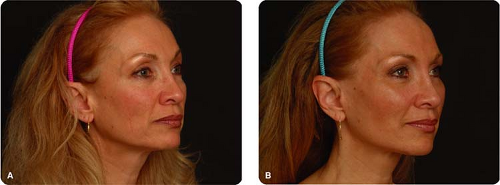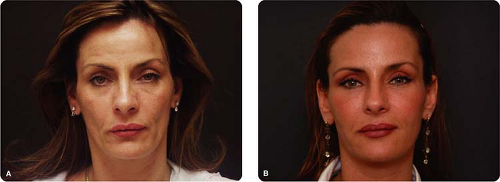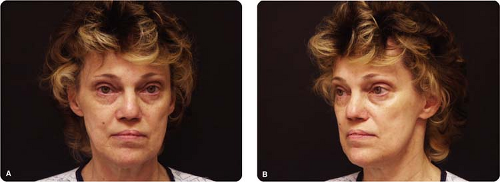Aesthetics and Aging: A New Paradigm
Introduction
Many book chapters and scientific papers have been written about the aesthetic evaluation of the aging face, with a plethora of lines and measurements, philosophies, and perspectives to instruct the reader in that analysis. This chapter will not review the past literature but instead will attempt to propose a new way of looking at the maturing face—one that is particularly relevant to the surgical therapies outlined in this book. In a certain respect, the aesthetic surgeon has to unlearn much of his or her education up to this point. Past theories on the aging face have focused solely on facial descent as the primary mechanism for facial aging. Accordingly, a facelift, browlift, and blepharoplasty were used as the principal weapons to combat and reverse the aging process. All of these procedures are contingent upon excision and lifting of redundant, prolapsed, or descended tissue.
A new paradigm has emerged to supplant this established dogma—the face does not descend so much as contract by virtue of volume loss. Two pioneers have led the charge for fat enhancement: Sydney R. Coleman of New York and Roger Amar of France. Coleman has been an eloquent and outspoken proponent of this new thinking. He reasons that the face undergoes soft-tissue and fat loss. Therefore, volume expansion with facial fat grafting is the method by which the aging process can be reversed. Roger Amar, a studious and meticulous individual, has advocated a strict anatomic program for facial rejuvenation known as FAMI (Fat Autograft Muscle Injection), in which fat is infiltrated systematically into the face using the facial muscles as the recipient bed.
A simple simile can be instructive and illuminating when thinking about the aging face in this light. A grape becomes a raisin with loss of volume; in a similar fashion, volume depletion of the aging face manifests as redundant skin. The effect of a facelift can be viewed as transforming the raisin into a pea by removing the redundant “shell” without addressing the volume loss. Therefore, returning the raisin to a grape, or the aged face to a youthful face, requires restoring the volume that is at least in part responsible for these changes.
When we look at the results of our past efforts to rejuvenate the face, we can see that excisional-based surgery has not truly provided all the answers to facial rejuvenation (Fig. 1-1). The hollowed-out eyes that result from removing fat and skin during a blepharoplasty surely are not the ideal of a youthful countenance. At times, a perfectly performed facelift may produce an unnatural surgical result and not a rejuvenated appearance. Clearly, there is more to restoring a natural, more youthful facial appearance than what just lifting can provide (Fig. 1-2).
Is volume expansion, then, the only method acceptable to rejuvenate the face? Should the experienced plastic surgeon who is adept at browlifting, facelifting, and the like, throw out all that he or she has learned and start over with just filling the face with fat? Certainly, many advocates of full-face fat transfer have shown remarkable clinical results that testify to the potency of fat grafting alone, with longevity that has rivaled traditional lifting procedures.
Although the aging face can be readily addressed in many circumstances with full-face fat transfer, the quantity of fat needed to achieve the intended result can be considerable, exceeding 100 cc during a procedure. Because proper fat infiltration requires multiple tiny passes with the infiltrating cannula to attain a viable, long-lasting result, an individual who has received a sizable amount of fat during a session can suffer from a marked recovery period, characterized by gross, lingering edema and ecchymosis. At times, traditional lifting procedures combined with fat grafting can reduce the amount
of fat needed to arrive at the desired result and thereby limit morbidity without aesthetic compromise (Fig. 1-3). Deciding whether to perform facial fat grafting alone, a lifting procedure, or a combination of the two will be thoroughly discussed in Chapter 2. Implementation of how to perform each type of procedure alone or in combination will then be discussed in Chapter 3. This book will not explain how to perform a facelift, blepharoplasty, or other types of surgical procedures, as sufficient numbers of books have already been written about these topics. The book assumes a prerequisite knowledge on how to perform non fat grafting rejuvenative procedures. The emphasis instead is on fat grafting and how to integrate it into an existing plastic surgical practice. If the surgeon is unfamiliar with other types of rejuvenative procedures and elects only to perform fat grafting, this book will also be useful toward that end.
of fat needed to arrive at the desired result and thereby limit morbidity without aesthetic compromise (Fig. 1-3). Deciding whether to perform facial fat grafting alone, a lifting procedure, or a combination of the two will be thoroughly discussed in Chapter 2. Implementation of how to perform each type of procedure alone or in combination will then be discussed in Chapter 3. This book will not explain how to perform a facelift, blepharoplasty, or other types of surgical procedures, as sufficient numbers of books have already been written about these topics. The book assumes a prerequisite knowledge on how to perform non fat grafting rejuvenative procedures. The emphasis instead is on fat grafting and how to integrate it into an existing plastic surgical practice. If the surgeon is unfamiliar with other types of rejuvenative procedures and elects only to perform fat grafting, this book will also be useful toward that end.
 Figure 1-3A, B: Pre- and postoperative views of a patient who underwent facelift to correct the lower face and fat transfer to improve the midface. |
We propose an integrated philosophy that permits the combination of lifting procedures with volume enhancement. Paradigms are merely models for viewing and understanding the world around us. No one paradigm can explain everything. Rather than subscribe to a single paradigm and constrain all of our view through the narrow confines of that model, we would like the reader to be more embracive of all techniques that can be beneficial for a particular patient and to select the combination of techniques that will work based on that patient’s particular anatomy and aesthetic desires. Like a painter with many sizes of brushes and a full color palette, the surgeon can be more creative and open when approaching the aging face. At times, full-face fat grafting will work beautifully (Fig. 1-4). Other times, lifting procedures alone will probably suffice. Most often, a judicious combination of both treatment modalities will be superior. As stated, Chapter 2 will guide the reader in a detailed preoperative evaluation of the face to determine which procedures will be best suited for a prospective patient. This chapter is intended only to set forth our paradigm of the aging face, which integrates prior work filtered through a new perspective.
Where should our search begin when looking for the quintessence of ideal, youthful beauty? Should we look at the aging face and think of how to rid it of unsightly wrinkles, sagging tissues, and the like? The answer is an unequivocal no. We should begin by determining what constitutes a youthful countenance so that we can strive toward that ideal. Too often, surgical plans begin and end with how to eliminate the face of “aging” without any clear understanding of youth. That is why a facelift can straighten a jawline but still leave the individual feeling as if he or she appears old. A pulled and stretched face does not necessarily resemble a youthful face or, more precisely, what the individual looked like in the past.
What makes a face appear young, vibrant, and ultimately alluring? When we look at a young face, how do we know that it is a youthful face? Is it just the
absence of lines and wrinkles? Is it just volume? Observing youthful faces will provide part of the answer. But, without a frame of reference it may still be difficult to delineate the changes that make an older face uniquely distinct from a youthful face. Reviewing photographs of patients when they were younger can elucidate these changes and help to establish the particular goals and plan for rejuvenating them. The remaining part of this chapter will be divided into three sections that describe the fundamental qualities of youth and the evolution of those qualities over time: Volume and Shape, Highlights and Shadows, and Framing the Eye. Viewing the youthful (and aged) face with these proposed principles will not only generate an insightful aesthetic philosophy but in so doing will serve as the underpinning for an effective and systematic surgical plan.
absence of lines and wrinkles? Is it just volume? Observing youthful faces will provide part of the answer. But, without a frame of reference it may still be difficult to delineate the changes that make an older face uniquely distinct from a youthful face. Reviewing photographs of patients when they were younger can elucidate these changes and help to establish the particular goals and plan for rejuvenating them. The remaining part of this chapter will be divided into three sections that describe the fundamental qualities of youth and the evolution of those qualities over time: Volume and Shape, Highlights and Shadows, and Framing the Eye. Viewing the youthful (and aged) face with these proposed principles will not only generate an insightful aesthetic philosophy but in so doing will serve as the underpinning for an effective and systematic surgical plan.
 Figure 1-4A: Preoperative photograph of a patient with significant global facial volume loss. B: Postoperative photograph following full-face fat transfer using a total of 63 cc of fat. |











